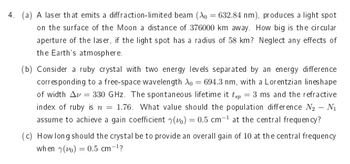Question

Transcribed Image Text:4. (a) A laser that emits a diffraction-limited beam (Xo = 632.84 nm), produces a light spot
on the surface of the Moon a distance of 376000 km away. How big is the circular
aperture of the laser, if the light spot has a radius of 58 km? Neglect any effects of
the Earth's atmosphere.
(b) Consider a ruby crystal with two energy levels separated by an energy difference
corresponding to a free-space wavelength Xo = 694.3 nm, with a Lorentzian lines hape
of width Av=330 GHz. The spontaneous lifetime it tsp = 3 ms and the refractive
index of ruby is n = 1.76. What value should the population difference N₂ - №₁
assume to achieve a gain coefficient () = 0.5 cm-¹ at the central frequency?
(c) How long should the crystal be to provide an overall gain of 10 at the central frequency
when y() = 0.5 cm-¹?
Expert Solution
This question has been solved!
Explore an expertly crafted, step-by-step solution for a thorough understanding of key concepts.
Step by stepSolved in 2 steps

Knowledge Booster
Similar questions
- A fiber laser (λ = 1.06 μm) has an output beam diameter of 1 cm. Find the diffraction limited spot size if the beam is focused by a lens with a 6 cm focal lengtharrow_forward4. Two mirrors with the same power reflectivity R are utilized to form a Fabry-Perot resonator. If the separation of the two mirrors is L and the refractive index inside the resonator is n, what is the Free Spectral Range Af of the resonator in the frequency (not the angular frequency Aw) domain? Here the Free Spectral Range (FSR) is the optical frequency spacing between two successive reflected/transmit ted optical intensity maxima/minima of a resonator.arrow_forward1. A helium-neon laser, radiating at 632.8 nm, has a power output of 3.0 mW. The beam diverges at angle 0.17 mrad as in fig 1. (a) What is the intensity of the beam 40m from the laser? (b) What is the power of a point source providing that intensity at that distance? Laser Figure 1: Helium neon laserarrow_forward
- 27. A 1385 kg cannon containing a 58.5 kg cannon ball is on wheels. The cannon fires the cannon ball, giving it a velocity of 49.8 m/s north. What is the initial velocity of the cannon the instant after it fires the cannon ball? ay. mB VA VBarrow_forwardYou are looking into the headlights of a distant vehicle on an autoroute in France. The driver has shown his resistance to the Europeanization of Europe by resolutely continuing to use yellow headlights (wavelength 550 nm). (a) What is the theoretical limit of angular resolution of your eyes for these headlights when your iris has a diameter of 6.00 mm? (Express your answer in milli-radians (mrad).) (b) If the headlights of the car are separated by 1.80 m, with this resolution at what distance would you be just be able to tell that the vehicle had, in fact, two headlights? (Express your answer in km.)arrow_forwardYou measure the distance between the finges of a diffraction pattern as follows: Distance (mm): 3.01, 3.27, 3.28 You measure the distance eight additional times to obtain the following ten values: Distance (mm): 3.01, 3.27, 3.28, 3.31, 3.16, 3.17, 3.15, 3.25, 3.18, 1.46 What values for the distance and uncertainty would you report using the first three measurements and the entire set of ten measurements? Group of answer choices First three: (3.22 ± 0.03) mm, All ten: (3.22 ± 0.02) mm First three: (3.19 ± 0.09) mm, All ten: (3.0 ± 0.2) mm First three: (3.186667 ± 0.07216237) mm, All ten: (3.201000 ± 0.02613236) mm First three: (3.216667 ± 0.02880329) mm, All ten: (3.216000 ± 0.02379916) mm First three: (3.240000 ± 0.04082483) mm, All ten: (3.217000 ± 0.02702036) mm First three: (3.24 ± 0.04) mm, All ten: (3.22 ± 0.03) mmarrow_forward
- PROBLEM For a given x-ray diffraction test (n = 1) on a cubic crystal structure, the recorded diffraction peaks (20) were 24.09°, 34.33°, 42.37°, 49.33°, 55.62°, and 61.48°. The x-ray wavelength used in the test was 0.15418 nm. For this test, determine the crystal structure of the element, the lattice constant, and identify the element.arrow_forwardX-rays of wavelength 0.130 nm are reflected from a certain crystal, and the first-order maximum occurs at an angle of 14.2°. What value does this give for the interplanar spacing of the crystal? ____nmarrow_forwardA 2mW laser beams of wavelength λ = 6×10 cm is focussed on the retina by a human eye lens of focal length f = 2.5 cm and pupil diameter 2 mm. The intensity on the retina will be of the order of (a) 10¹ W/m² (b) 106W/m² (c) 108W/m² (d) 10²W/m²arrow_forward
- 3. A Cu target emits an X-ray line of wavelength = 1.54 Å. a) Given that the Bragg angle for reflection from the (111) planes in Al is 19.2°, compute the interplanar distance for these planes. Recall that aluminum has an fcc structure. b) Knowing that the density and atomic weight of Al are, respectively, 2.7 g/cm3 and 27.0, compute the value of Avogadro's number.arrow_forwardPluto and its moon Charon are separated by 19600 km. An undergraduate researcher wants to determine if the 5.08 m diameter Mount Palomar telescope can resolve these bodies when they are 5.40×109 km from Earth (neglecting atmospheric effects). Assume an average wavelength of 545 nm. To determine the answer, calculate the ratio of the telescope's angular resolution ?T to the angular separation ?PC of the celestial bodies.arrow_forwardProblem 19: Sodium vapor light (average wavelength 598 nm) falls on a single slit of width 7.75 μm.Randomized Variablesλ = 598 nmw = 7.75 μm At what angle θ, in degrees, does it produces its second minimum?Numeric : A numeric value is expected and not an expression.θ = __________________________________________arrow_forward
arrow_back_ios
SEE MORE QUESTIONS
arrow_forward_ios